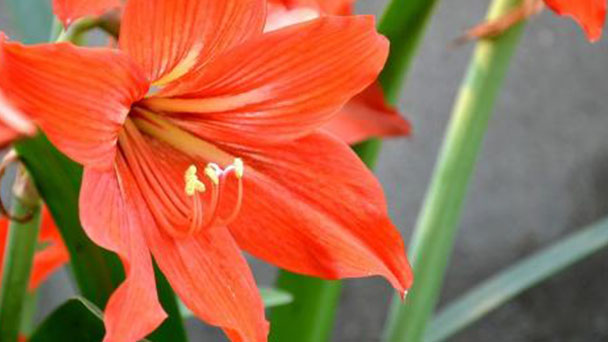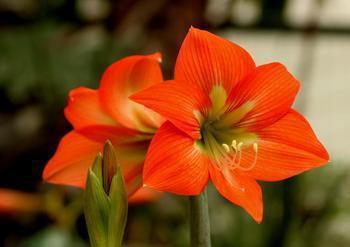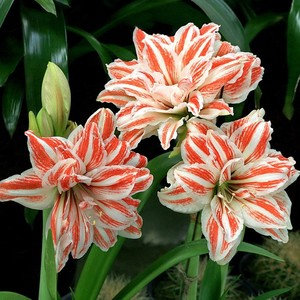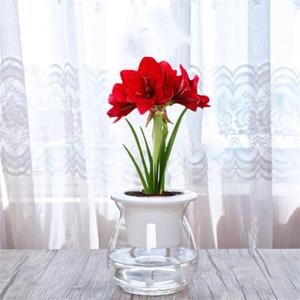Amaryllis (Hippeastrum) profile
Written by Maggie
Mar 31 2021

Amaryllis (Hippeastrum rutilum) is a perennial herb of Amaryllis (Hippeastrum) of Lycoris family.
Amaryllis (Hippeastrum) bulb is subglobose, leaves 6-8, extruded, bright green, flower stem hollow, slightly oblate, with white powder; Tepals are green, cylindric, lobes oblong, apical, magenta, greenish, throat with small scales.
Amaryllis (Hippeastrum) is distributed in Brazil and Hainan Province, China, and has been artificially introduced and cultivated. Amaryllis (Hippeastrum) was specially produced as canned flowers by European and American horticulturalists for the convenience of flower farmers.
Amaryllis picture

Amaryllis (Hippeastrum) info
| Botanical Name | Hippeastrum (Group) |
| Common Names | Amaryllis |
| Plant Type | Perennial bulb |
| Sun | Full sun, partial sun |
| Hardiness Zones | 8 to 10 (USDA) |
| Flower color | Red, pink, white with spots and bands |
| Native Area | Central and South America |
| Mature size | 1 to 2 feet tall; 9- to 12-inch spread |
Morphological characteristics of Amaryllis (Hippeastrum)
Stems
Bulbs of Amaryllis (Hippeastrum) are subglobose, 5 -- 7.5 cm in diameter, and with stolon prunes.
Leaf
Amaryllis (Hippeastrum) has 6-8 leaves, extruded, bright green, banded, ca. 30 cm long, ca. 2.5 cm wide at base.
Flowers
Amaryllis (Hippeastrum) has a hollow, slightly oblate flower stem, ca. 40 cm tall and 2 cm wide, with white powder; 2-4 flowers; Involucral bracts are lanceolate, ca. 3.5 cm long; Pedicels are slender, ca. 3.5 cm long; Perianth tubes are green, cylindric, ca. 2 cm long, perianth lobes oblong, apical, ca. 12 cm long, ca. 5 cm wide, magenta, greenish, throat with small scales; Amaryllis (Hippeastrum) has 6 stamens, ca. 8 cm long, filaments red, anthers linear-oblong, ca. 6 mm long, ca. 3 mm wide; Ovary ca. is 1.5 cm, style ca. 10 cm, stigma 3-lobed.
Ecological habits of Amaryllis (Hippeastrum)
Amaryllis (Hippeastrum) is fond of warm and humid climate, and the suitable temperature for growth is 18 ~ 25℃. It does not like intense heat, and the sun should not be too strong, so it should be conserved under a greenhouse. Fear of the flooding.Winter dormant period, the requirement of cold and wet climate, to 10 ~ 12℃ is appropriate, not less than 5 °C. They like the sandy loam rich in humus and well drained.
If the winter soil moisture is high and the temperature exceeds 25℃, the stem and leaves of Amaryllis (Hippeastrum) will grow vigorously and hinder dormancy, which will directly affect the normal flowering of the next year. Light also had a certain effect on the growth and flowering of Amaryllis (Hippeastrum). In summer, strong light should be avoided for a long time, and sufficient sunlight should be needed for winter cultivation. The soil should be loose and fertile sandy loam with a pH of 5.5 ~ 6.5. Water accumulation should be avoided.
How to grow and care for Amaryllis (Hippeastrum)
Water
Keep the Amaryllis (Hippeastrum) moist and water thoroughly. But avoid excessive moisture, poor drainage.General indoor air humidity can be.
Fertilizer
During the growth period with the growth of leaves every half a month fertilizing 1 time, stop fertilizing in the flowering period, continue to fertilize after the flower, with phosphorus, potassium fertilizer, reduce nitrogen fertilizer, can stop fertilizing in the late autumn. Potted plants can add some superphosphate as a base fertilizer.
Soil
Amaryllis (Hippeastrum) requires sandy loam rich in organic matter, requires good drainage, and avoids heavy clay soil.
Temperature
In winter the dormant period can be cool and dry. The suitable temperature for growth is 5℃ -10 ℃.
Light
Amaryllis (Hippeastrum) likes sunshine, and can get the right amount of direct sunlight, not too long. Appropriate placement in the light is bright, ventilated good, without the window that strong light shoots directly.
Pruning
When the flowers fade, cut the flower stalk back to just above the bulb. Keep watering the plant until it goes dormant in the fall. You can move the amaryllis outdoors for the summer, placing it in a part-shade location.
The propagation of Amaryllis (Hippeastrum)
Amaryllis (Hippeastrum) is commonly propagated by seeding, pellet splitting and cutting.
Seed propagation
That is, the germination rate is high. The seeding soil was 2 parts peat soil mixed with 1 part river sand. The seed of Amaryllis (Hippeastrum) is large, suitable for sowing on demand, the spacing is 2 ~ 3 cm, the suitable temperature for germination is 15 ~ 20℃, 10 ~ 15 days to emerge seedlings, 2 true leaves at seedling time. It takes two to three years from sowing to flowering.
Ball propagation
Old bulbs of Amaryllis (Hippeastrum) can produce 2 to 3 small bulbs per year, which can be removed and replanted. Be careful not to damage the root of the bulb and keep the top of the bulb above the ground. The bulb will flower in about 2 years.
Use artificial chop more blooms ball, the mother bulb longitudinal cut into several pieces, again in the middle is divided into two and a half, the bottom attached to each part of the bulb plate as the root, then the cuttings in peat soil mixed with sand of cuttings bed, appropriate water, after 6 weeks, can occur between scales 1-2 balls, and takes root in the lower part.Such a female bulb can be nearly a hundred young bulbs.
Amaryllis (Hippeastrum) is easy to fruIt 'and can be artificially pollinated at the flowering stage. The seeds mature after 2 months, and there are about 100 seeds in each capsule. Seed after harvest, high germination rate. After sowing, place it in half shade and keep it moist and at a temperature of 15 ~ 18℃. It can sprout in half a month. If the temperature reaches 18 ~ 20℃, germinate after 10 days. Seed propagation takes 3 to 4 years to flower. Balloon propagation is carried out in March to April. The pellets around the cue ball are removed and planted with the top of the bulbs exposed to the soil.
Cutting propagation
Cut the cue ball of Amaryllis (Hippeastrum) longitudinally into sections, then cut its scales and insert them diagonally into vermiculite or sand. Transplant when 2 true leaves grow. When planting pseudobulbs, the pot soil is too easy, which will delay the flowering or reduce the number of flowers. A mixture of sandy loam 5 parts, peat 2 parts and sandy 1 part can be used. The planting depth should be 1/3 of the bulb exposed to the soil surface.

Disease & pest control of Amaryllis (Hippeastrum)
The main diseases of Amaryllis (Hippeastrum) include virus disease, speckled disease, nematode disease and erythema.
Disease control
Speck
Harm leaves, flowers, scapes and bulbs of Amaryllis (Hippeastrum), round or fusiform russet spots, especially in autumn. Diseased leaves should be removed; Before planting, the bulbs were immersed in 0.5% formalin solution for 2 hours, and the same amount of Bordeaux solution was sprayed regularly in spring.
Virus disease
Amaryllis (Hippeastrum) root, leaf decay, available, invasive causes leaves and stems and flowers, and gradually spreads to the bulb direction.Bulbs need to be soaked in 43℃ warm water with 0.5% formalin for 3-4 hours to achieve control effect.
Red spot disease (Stagonospora curtisii)
Red spot affects leaves, flowers, scapes, and bulbs of Amaryllis (Hippeastrum), producing round or fusiform reddish brown spots, especially in autumn. Diseased leaves should be removed; Soak the balls with 0.5% formalin solution for 2 hours before planting, spray Bordeaux solution for prevention in spring. The insect pest is red spider.Spray 90% insecticide ether powder 1000 times liquid.
Nematode disease
The nematode mainly invades from the stomata of leaves and flower stems, and then causes the disease of leaves, stems and flowers, and gradually spreads to the direction of bulbs. Bulbs should be soaked with 0.5% formalin in 43℃ warm water for 3 ~ 4 hours to achieve the control effect.
Pest control
Starscream
Insects have red spider harm, can be used 40% dichlorophenol emulsion 1000 times liquid spray kill.
Species classification of Amaryllis (Hippeastrum)
Red Lion: The flower is deep red.
Hercules: Orange - red flowers.
Rilona: Pale orange-red flowers.
Telstar: Large flower species with bright red flowers.
Flowerrecord: The flowers are orange-red with white stripes.
Souvereign: Floral orange
Minerva: Large red flowers with white centers.
Picotee: White to greenish flowers with red edges.
The distribution of Amaryllis (Hippeastrum)
Amaryllis (Hippeastrum) is native to Peru and Brazil, and is widely cultivated in all countries.
Amaryllis (Hippeastrum) was specially produced as canned flowers by European and American horticulturalists for the convenience of flower farmers. Up to now, the company has a large production capacity in Europe. In 1995, the sales output value of Amaryllis (Hippeastrum) in the Netherlands, the main producer country, reached 19.1 million US dollars. Belgium, Germany, France and Spain have certain production. In Asia, Amaryllis (Hippeastrum) bulbs are produced in the eastern region of India, but the production facilities are poor and the quality is poor. During 1912 ~ 1949 in China, Amaryllis (Hippeastrum) was ornamental in pots in Nanjing, Shanghai and other places. In the 1970s, it began to be planted around open-ground gardens in southern China as landscape appreciation. Many excellent varieties have been introduced from abroad in China, and many of them are dwarf varieties suitable for potted ornamental cultivation, which created conditions for the development and utilization of Amaryllis (Hippeastrum).
In 1920 the precious pure white variety was produced in the United States. The Netherlands and Japan have also made great progress in breeding.Amaryllis (Hippeastrum) has more horticultural species.
Amaryllis (Hippeastrum), originally from Peru's Andes Mountains, was introduced to Europe in 1769.Amaryllis, native to the Cape of Good Hope in South Africa, was introduced to Europe in 1633.It is found in most provinces in China.
Amaryllis (Hippeastrum) uses
Medical use
Amaryllis (Hippeastrum) can promote blood circulation and detoxify, dissipate blood stasis and detumination.
Garden use
Amaryllis (Hippeastrum) is suitable for potted plants to decorate homes, living rooms, hallways and corridors. It can also be grown in the courtyard, or with a flower bed.
Amaryllis (Hippeastrum) is also available as a fresh cut flower.

Latest Updated
- Benefits of Bugleweed - 7 Science-backed Health Benefits
- Bugleweed Dangers & Side Effects - Is It Poisonous?
- How to Plant Evergreen Trees - What You Should Know
- When to Plant Evergreens - Grow Guide for Evergreen Trees
- 12 Wonderful Evergreen Shrubs for Your Garden
- 12 Popular Evergreen Plants with Pictures for Beginners
- When And How To Prune A Lilac Bush Like a Pro
- How to Grow & Care for Lilac Vine (Hardenbergia Violacea)
- Japanese Lilac Tree (Syringa Reticulata) Care & Propagation Guide
- Shumard Oak Pros and Cons - What to Know
Popular Articles
- Winter maintenance of Antirrhinum Majus
- How to Grow Terminalia Mantaly Tree
- How to Grow and Care for Crossostephium Chinense
- How to grow Antirrhinum Majus in spring
- Peristeria Elata (Dove Orchid) Profile: Info & Care Guide
- Underwatered Snake Plant (Sansevieria Trifasciata) - Signs And How To Fix
- How to Care for Brazilian Jasmine Plant (Mandevilla Sanderi)
- How to Grow & Care for Graptopetalum Purple Delight in Summer
- Rosa Chinensis (China Rose): Plant Growing & Care Tips
- How to Care for Baby Sun Rose (Aptenia Cordifolia)